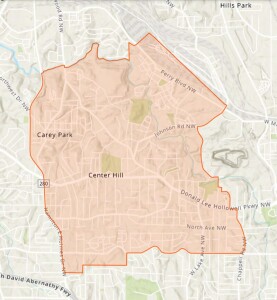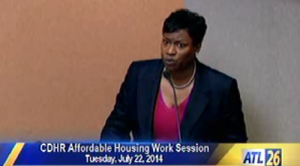NPU Secures Deep Affordability Option in Atlanta Housing Policy
 (APN) ATLANTA — On Monday, March 15, 2021, the City Council of Atlanta approved City of Atlanta Ordinance 20-O-1729, requiring affordable housing to be included in new housing developments surrounding the Westside Park that is currently being developed.
(APN) ATLANTA — On Monday, March 15, 2021, the City Council of Atlanta approved City of Atlanta Ordinance 20-O-1729, requiring affordable housing to be included in new housing developments surrounding the Westside Park that is currently being developed.
Due to neighborhood advocacy, the policy–known as an “Inclusionary Zoning policy” (IZ)–expands the definition of affordability to include truly affordable, or deeply affordable, housing units, at thirty percent of the Area Median Income (AMI), or rents of 550 dollars per month for a two bedroom apartment or home.
(Please see “Exh. A, March 08, 2021 substitute.”)
Previously, in 2017, the City of Atlanta approved two IZ zones for the Atlanta Beltline and Westside neighborhood, the latter of which targeted the high-density area along Northside Drive.
However, the previous IZ policies only gave developers an option to comply with the affordability requirements by setting aside units at either sixty percent AMI (ten percent of units) or eighty percent AMI (fifteen percent of units), meaning rents of approximately 1,100 dollars per month and 1,600 dollars per month.
Such rents are out of reach for many families relying on incomes in the service sector, earning at or around minimum wage.
The amendment for true affordability was due to the advocacy of neighborhood organizations, including Neighborhood Planning Unit K (NPU K), which adopted a resolution at its Feb. 16, 2021 meeting encouraging the Mayor, Council, and Department of Planning to amend the ordinance. APN’s News Editor, the present writer, who is a member of NPU-K, drafted and introduced the resolution.
The policy was expanded to include a deeper level of affordability that is intended to provide new housing options for the low-income families currently living on the Westside who are in danger of being displaced by the forces and mechanisms of gentrification, that are, in turn, being fueled by millions of dollars of public investment on the Westside.
Housing advocates had criticized the City’s two existing IZ policies, both adopted in 2017, for failing to truly be inclusionary, for requiring so-called “affordable” units that failed to serve Atlanta’s working families who are most in need of affordable housing options.
For years, affordable housing advocates had been pushing for Atlanta to adopt an IZ policy, but were distraught that Atlanta had seemingly adopted an exclusionary zoning policy in the name of being inclusionary.
Under the amendment adopted by the Council, developers will now have an option to comply with the affordable housing requirements by producing five percent of their units at thirty percent of the AMI.
Thus, if a developer chose to produce units at 550 dollars per month, they would be on the same footing as developers who choose to produce “affordable” units at higher price points, by being able to produce proportionately fewer units.
 In 2017, advocates including Sherise Brown of Atlanta’s Peoplestown neighborhood, said that Councilman Andre Dickens (Post 3-at-large) misled community members by telling them that the first two IZ ordinances would include an option at thirty percent AMI.
In 2017, advocates including Sherise Brown of Atlanta’s Peoplestown neighborhood, said that Councilman Andre Dickens (Post 3-at-large) misled community members by telling them that the first two IZ ordinances would include an option at thirty percent AMI.
For years, the gatekeepers of housing policy in Atlanta had insisted that it was absolutely not feasible to produce units affordable at thirty percent AMI because they said it was too cost-prohibitive to developers.
http://atlantaprogressivenews.com/2016/10/30/editorial-30-percent-ami-on-the-beltline-now-or-never/
 During a 2016 Work Session, then-Director of the Office of Housing, Terri Lee, told Councilman Michael Julian Bond (Post 1-at-large) that requiring units at thirty percent AMI as part of a City IZ policy would be unfeasible; and that she would provide an analysis at the next committee meeting. Lee did not provide the analysis.
During a 2016 Work Session, then-Director of the Office of Housing, Terri Lee, told Councilman Michael Julian Bond (Post 1-at-large) that requiring units at thirty percent AMI as part of a City IZ policy would be unfeasible; and that she would provide an analysis at the next committee meeting. Lee did not provide the analysis.
“So… we actually ran numbers in conjunction with citywide, what threshold we could actually do where the development deals could still be completed. And that was the 60 percent and the 80 percent…” Lee said at the time.
“But again, we’ve heard our stakeholders very loudly and we also hear the concerns that both have been stated by you and Councilmember (Kwanza) Hall. We will work with our team to develop those numbers you’re asking for for the next meeting and the next discussion.” Lee said.
Lee did not provide the information, but APN made a records request in 2016, at which time the Office of Housing provided two analyses showing that, in fact, it was feasible to produce units affordable at thirty percent AMI, but that fewer affordable units could be required.
This clarification regarding feasibility laid the groundwork for the IZ amendment.
“The significance of this thirty percent AMI in the Ordinance is, it includes lower income people into this zoning,” Sherise Brown told Atlanta Progressive News. “This is the most unmet need. This is what inclusionary zoning looks like.”
“The community leadership within NPU-K to champion this speaks volumes. It can be done. We need to include the most vulnerable residents in these new affordable housing developments,” Brown said.
“This is what we ask the City to include in their inclusionary zoning. Every little bit counts. This model should be used and adopted by all neighborhoods.”
The amendment for thirty percent AMI units enjoyed the support of the Mayor, the Department of Planning, and the Council.
 “With our new Westside Quarry Park opening soon, it is of the utmost importance that surrounding neighborhoods have quality, affordable housing,” Mayor Keisha Lance Bottoms said in a press release.
“With our new Westside Quarry Park opening soon, it is of the utmost importance that surrounding neighborhoods have quality, affordable housing,” Mayor Keisha Lance Bottoms said in a press release.
“Our Westside communities and legacy residents are the bedrock of our city, and our Administration will take the necessary actions to ensure development is carried out in a thoughtful, inclusive manner.”
Previously, Mayor Bottoms initiated a development moratorium for generally the same area, to address gentrification concerns.
 “I… thank the neighborhoods and NPUs for their involvement and input, as well as the Department of City Planning and former Chief Housing Officer Terri Lee for their expertise in crafting the legislation,” Atlanta City Councilman Dustin Hillis (District 9), who sponsored the legislation and represents the District where the park and IZ zone is located, said in a press release.
“I… thank the neighborhoods and NPUs for their involvement and input, as well as the Department of City Planning and former Chief Housing Officer Terri Lee for their expertise in crafting the legislation,” Atlanta City Councilman Dustin Hillis (District 9), who sponsored the legislation and represents the District where the park and IZ zone is located, said in a press release.
“It’s vital that we have affordable housing on the Westside, especially as we’re facing a housing boom with the development of the Westside Park and the announcement of Microsoft establishing a large corporate campus in Grove Park,” Hillis said.
“There are real and growing concerns about affordability for our low- and mid-income residents in the community, and I’m grateful that my colleagues on the Council joined together to adopt this ordinance. As we see property values soar, this is a smart and needed step for our community,” Hillis said.
Around the time of the demolition of public housing in Atlanta in the 1990s, around the time of the Olympics, it was more common for the City to produce through public policy housing units affordable at thirty percent AMI.
The City even adopted in 2001 an aspirational goal that “All public subsidies for affordable housing should [be] targeted so that two-thirds of the subsidies reach extremely low income families.” (City of Atlanta Code of Ordinances, Part II, Chapter 54-1)
However, in 2016, in a demonstration of how far the City had strayed from its original housing policy, the City attempted to redefine “affordable housing” to include units affordable at eighty percent and above, instead of the existing definition of fifty percent and below.
The City instead adopted a parallel definition of “affordable housing” for the purposes of workforce housing policy allowing for so-called affordable housing to be produced at eighty percent and above.
The passage of the amended IZ ordinance earlier this month thus represents a huge restoration of housing policy in the City of Atlanta, made possible by years of advocacy.
(END / Copyright Atlanta Progressive News / 2021)